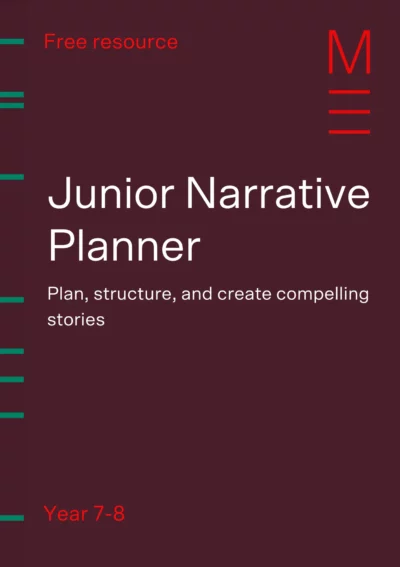Welcome to Matrix Education
To ensure we are showing you the most relevant content, please select your location below.
Select a year to see courses
Learn online or on-campus during the term or school holidays
Learn online or on-campus during the term or school holidays
Learn online or on-campus during the term or school holidays
Learn online or on-campus during the term or school holidays
Learn online or on-campus during the term or school holidays
Learn online or on-campus during the term or school holidays
Learn online or on-campus during the term or school holidays
Get HSC Trial exam ready in just a week
Get HSC exam ready in just a week
Select a year to see available courses
Science guides to help you get ahead
Science guides to help you get ahead

Creative writing can be hard, but it needn’t be. Many Year 6 students get overwhelmed by creative tasks. In this post, we’ll show you how to write a Year 6 creative in 8 steps as if you were in Year 7.
Get ready to rock your marker!
Plan, structure, and create compelling stories with templates and engaging prompts! Fill out your details below to get this resource emailed to you. "*" indicates required fields
Get your FREE Junior Narrative Planner + Prompt

Get your FREE Junior Narrative Planner + Prompt
This is the process we teach students for writing high scoring creatives:
Many High School students struggle with creative writing. So, it is no wonder that Year 6 students find creative writing difficult.
Year 6 students tend to get frustrated because they can come up with imaginative ideas, but then have difficulty developing them.
These are common problems. And the good news is that they can be solved by following a process!
We’ve developed a method for writing compelling and exciting creatives that will work for Year 6 students all the way to Year 12!
What we’re going to do now is step you through the step-by-step process for writing fantastic creatives.
The secret to doing anything well is following a process. Just because narratives are creative doesn’t mean they just pour out of you.
No. There’s a reason it’s called the creative PROCESS!
So, let’s go through the Matrix step-by-step process for writing creatives.
Narratives require a character to be engaging. This is because we relate to people (or anthropomorphised creatures – like Simba from the Lion King or Groot from Guardians of the Galaxy.
One of the things that makes characters compelling is having qualities and flaws that are prominent and change over the course of the story.
So, the first thing you want to do is decide on who your character is.
You should use a table to plan out your character details.
| Table for Character Creation | ||
| Feature | Detail | Notes |
| Name | Farah Guzman | If you’re stuck you can always use a random name generator |
| Age | 16 | This will depend on the story you are telling. Is it about Teenagers taking on a dystopian government? Or strangers surviving in the wilderness after a plane crash? |
| Gender | Male | What gender is your character? |
| Class | Upper Middle | What economic background |
| Background | Born in Sydney Parents run a small business Goes to a local selective school | What is their background? Where did they grow up? What experiences have they had? How will this shape their character? What characteristics have they developed that they will need to change over the course of the narrative? |
| Likes | Fortnite Gong-cha The band, Idles Real Madrid Science Playing bass | What a character likes says a lot about them. A character who likes gaming may not spend enough time outside. But somebody who follows Eurpoean football teams may be sports-mad. Musical or scholastic interests show what culture a character might be into. Leaning into stereotypes in the initial parts of the story can be an interesting way to challenge them at the denouement (the climatic part) of your story |
| Dislikes | English homework Public transport Jules and Julia, the twins at school who bully him Orchestra practice Teta’s baklava which is way too dry and he can’t say is terrible | Likewise, what a character doesn’t like, and why they don’t like it, can flesh out a character and set up the development or transformation. |
| Beliefs / ideologies | Eww. Politics? Who has time for that? He can’t stand Man U, though. | What a character stands for (be it religion, politics, choice of shoes) can tell a reader a lot about their motivations and foreshadow the sort of transformation they may undergo. |
| What are they going to do? | Develop a better relationship with his Grandparents and become a rock star | Finally, you need to figure out what it is that the character is going to have done by the end of the story. This will give you the basis for planning your ending. You won’t plan a narrative successfully unless have an ending in mind as you start developing the plot. |
Once you’ve created a character, you’re in a position to start figuring out what happens to them.
Sometimes it is hard to figure exactly how your story ends.
That’s okay. Writing endings, especially good endings, is the hardest part of writing a story.
Remember, you don’t need to produce a complete resolution. Farah doesn’t need to learn how to be a perfect bassist or acquire a taste for his Teta’s baking. You just need to show what the next logical step is in his development.
Here are some questions to ask when deciding on an appropriate ending:
It doesn’t matter if you can’t totally pin down the exact ending, you can always develop it further as you work through the second or 3rd draft
Once you’ve figured out a rough ending, you can plan out the structure in more detail.
Narratives work because they have characters we care about (like the one you just created!) that have interesting and relatable things happen to them.
When you are trying to figure out the broad elements of the narrative, it may help you to break it down into three parts:
| Table: Plot planner | ||
| Part | Detail | Note |
| Introduction | Farah is playing a quick game of Fortnite before getting ready to go to his mate’s house to have band practice His Mum comes into his room and scolds him for having a dirty, room, reminding him that they have to go see Teta and Gido (Grandma and Grandpa) at the hospital Farah has forgotten and is pretty unhappy | Note down the setting Introduce the relevant characters Include a character introduction |
| Complication | At the hospital, Farah has to eat Teta’s Baklava and is anxious about keeping his mates waiting for band practice. He’s a good cello player, but not great at bass. He’s worried his mates will get a new bassist. Farah’s Gido asks him to play something | Once the characters are introduced and the protagonist has been developed present them with a challenge that makes them uncomfortable |
| Resolution | Farah stumbles through some basic bass riffs. Farah’s parents chide him for not bringing his cello. His Gido takes the guitar and plays some mad riffs. And explains how he used to be in a Beirut punk band before the civil war and fleeing to Australia. His Gido agrees to teach Farah how to play bass if he agrees to stop complaining about Teta’s baklava. | Think about how the character would solve their problem You don’t have to solve the issue, but you need to offer a resolution that addresses it. Maybe they realise they need help or figure out a way to solve things. |
When you plan structure you need to consider:

Step 4a: Choose your plot scaffold
A plot scaffold develops your plot in more detail and gives you the structure to tell it. Do you want to use a flashback as a narrative device or would you rather tell your story from start to finish?
Your choice here would shape your plot scaffold. Below is a pair of flowcharts illustrating the two most common scaffolds:
One scaffold is not better than the other. Flashbacks can be confusing, cliche or unnecessarily convoluted, similarly linear narratives can be predictable or a little plain.
You will need to play around to see which one works best for YOUR story.
You’ll notice that this is more detailed than the initial plot structure:
Let’s see what this might look like:
| Part | Detail | Example |
| Orientation | Introduce the protagonist and the setting. Orient the reader | Farah is playing Fortnite in a messy bedroom |
| Trigger | Add an incident that sets things in motion | Farah’s Mum bursts in the room |
| 1st Complication | Something occurs which complicates the characters life | Farah has to go with his family to his grandparents in the hospital Farah is meant to have band practice with his friends. He’s anxious they will replace him with Jim, a cool kid who is better at playing bass. |
| 2nd Complication | A further complication makes his life even more difficult | His grandmother has brought homemade baklava that he doesn’t want to eat but his parents insist on him eating Farah has talked up his bass playing skills, overstating them. His sick grandfather wants him to perform. Farah plays badly and gets into an argument with his parents over being in the band and not practising his cello and neglecting his parents Things get heated |
| Resolution | The protagonist arrives at a solution and perhaps begins enacting it or planning how to execute it | Farah’s grandfather picks up the bass guitar that was leaning against the bed and plays some riffs, silencing the room His grandmother explains his past in bands in Beirut and how he never had time to play when they got to Australia Farah agrees to spend more time with his grandparents so he can learn from his grandfather |
| Table: Plot scaffold example | ||
Step 4b: Choose your tense
Once, you’ve picked a scaffold, you need to decide if it is told in the present or the past tense.
Writing in the simple past is the most common. It is easy to read and relatively straight forward to write.
Narratives written in the present continuous (-ing) are not uncommon but are a little harder to write. They can become hard to follow when characters in the present are remembering events in the past or they can seem overly simple and childish.
Blake Crouch’s Dark matter (2017) is a good example of an engaging and well-written present continuous narrative. You can read a sample on this page.
You should think about whether the events in the narrative are being narrated as they happen to the protagonist or if they are being remembered later on:
Step 4c: Choose your perspective
You have three choices when choosing the perspective your story is narrated from:
if you’re just getting confidence writing narratives, you’ll find it easiest to start off with a third-person perspective. As you develop confidence and skill, you should start practising first-person narration.
As a rule, second-person narration should be avoided intially as it is to get wrong and can seem quite gimmicky.
To help you choose, here are some pros and cons for each tense:
| Tense | Pro | Cons |
| Table: Pros and cons of narrative perspectives | ||
| 1st person | Relatively easy to write Let’s you get right into a character’s head You can see how they think of others Understand their emotional state (happy, sad, scared) | LImited to one perspective Can be tempting to get too involved in character’s emotions Can’t really see the bigger picture or get to know other characters |
| 2nd person | Involve the reader in the text Develop tension | Hard to write Can be disorienting Only good for certain narratives (adventure, action, horror) |
| 3rd person | Easiest to write Lets you show the bigger picture You can describe all events and characters Can dip into character’s thoughts | Can have too much going on Only allows a superficial or momentary insight into a character Easy to include too much information |
Okay, now you’ve done your planning, you’re ready to… write your 1st draft!
First things first,
It’s okay for your first draft to suck!
Like, really really suck. That’s okay. That’s the point of a first draft. it is a starting point for something much much better.
Be prepared to produce something terrible and then rebuild it into something great!
Now grab your plan and we’ll develop a first draft.
Let’s see how you should do that:
Step 5a: Compose the orientation
Your narrative needs a compelling hook. It also needs to introduce the characters and setting.
Don’t worry too much about getting the hook right in the first draft.
Introduce the setting and prominent characters by providing brief descriptions rather than detailed ones. Stories are more effective when the reader gets to paint the picture of characters.
For example, compare these two openings:
See the difference between the two? The first is more concise and only gives the reader as much information as they need. The second is much too detailed and in the process of being detailed loses any tension.
When writing your orientation, aim to only introduce the setting and key characters. You can start developing things further when you introduce the trigger.
Step 5b: Write your trigger
The trigger is an incident that sets the course of events in the narrative in motion. It could be something small like something said in a conversation. Or it could be something huge like an alien invasion.
You should make it clear that your trigger is important. You do this by describing the protagonist’s (and other characters’) response to it.
Step 5c: Write the 1st complication
The first complication is an obstacle that a character or characters encounter
Remember, complications are meant to provoke the character to find a solution to something and to have an emotional response.
For example, in Farah’s story, the first complication is being told by his Mum that he needs to go with the family to see his Teta and Gido at the hospital. He doesn’t want to go he has band practise with his friends, but has no choice but to go to the hospital.
When you write your complication, be sure to explain what the character’s response to it is. Describe their physical response and consider how they speak to people about it.
Ask yourself:
Then you can describe what the characters do in response to the first complication.
Step 5d: Write the 2nd complication
The second complication occurs while the character(s) is overcoming the first one.
As in the first one, you need to describe:
For example, in Farah’s case, the second complication occurs when his Grandma gives him a hard time about not playing the cello and challenging him to play them some music. It doesn’t go well, Farah isn’t as good a bass player as a cellist.
Once you’ve written the complication and its consequences, you can finish the story by writing the resolution.
Step 5e: Write the resolution
A resolution is where you conclude the narrative.
When you resolve a narrative, you don’t need to write the complete ending!
What does this mean? When you write a creative, you are only relating a short series of events that happen to a character or group fo people. You don’t need to tell their whole life stories!
Instead, you need to think about what part of their lives you want to relate and focus on that.
For example, in Farah’s story, we don’t need to see him go to his band practice after the hospital trip. Instead, we can focus on a smaller resolution. Farah’s Gido reveals he was in a punk band, plays some really good music, and explains why he left Lebanon in the 80s. He agrees to teach Farah how to play bass. The end.
When you edit a piece of work you want to break it down into two types of editing:
To edit your creative, you want to tick off the items on the following checklist.
✔ Macro: Check for plot holes
Read through your story, make sure all of the events make sense.
Ensure there are no logical flaws.
✔ Macro: Look for consistency
Make sure you’ve used the correct tenses throughout.
Ensure sure you haven’t confused tenses.
Make sure the perspective is consistent throughout.
✔ Macro: Choose a symbol/ leitmotif and develop it
You need to develop a symbol, symbols, or leitmotif (a recurrent symbol) throughout.
For example, instruments in Farah’s narrative show his passion and come to be a leitmotif showing his renewed connection to his Gido
✔ Micro: Develop your dialogue
Dialogue is important. It shows the reader how characters relate to one another.
Dialogue is hard to write right.
It takes practice. When learning how to write dialogue, focus on keeping it tight by only including dialogue that:
If it doesn’t do any of the above, then it is unnecessary.
✔ Micro: Incorporate techniques
You need to include techniques in your writing to help represent things.
This is how you SHOW and don’t tell.
Look for parts of your narrative where you only describe things in plain language and change them to using techniques like rhetorical questions, metaphors, similes, or symbols to convey your meaning.
For example, consider the following statements:
The second statement might be longer but, clearly, it is more evocative because it compares Farah’s mood to a black hole.
✔ Micro: Edit for grammar
Read your narrative aloud. This will help you find grammatical mistakes and other errors.
You should:
if you want help learning about grammar. You must read our English grammar Toolkit.
✔ Micro: Edit for concision
Finally, you want to get rid of all of the rambling and fluff from your story.
Short stories are meant to be concise. You don’t want to waste a reader’s time. Instead, you want to make sure that the action is moving along throughout.
Read through your narrative and consistently ask yourself:
Does my reader need to know this?
If the answer is no, then you should consider removing or rewriting it.
Once this is done, you’ve finished your first draft!
WELL DONE!
That’s the hardest bit done.
Now you need feedback.
Once you’ve got the first draft and tidied it up, you’re ready to get some feedback.
Feedback is important, as it will tell you what works in your narrative and what doesn’t.
When we write, it is often very easy to write for ourselves:
Feedback is a way of identifying these issues.
It can be hard receiving criticism on our work. Sometimes we don’t like hearing that our work isn’t fantastic.
It’s really important that you separate criticism of your work from criticism of you. The two are not the same (take note, parents!)
To get effective feedback, it will help if you give your reader a feedback form so they can tell you what they like and don’t like.
Step 7a: Give your reader a feedback form:
| Sample feedback form for your readers | |
| Question | Reader’s comment |
| What did you like about the story? | |
| What did you not like about the story? | |
| Did you find any grammatical errors? | |
| Were there any plot holes? | |
| What does the story need more of? | |
| What does the story need less of? | |
| Final remark | |
Once you get the feedback, you want to review it and take on board what the reader says.
You don’t need to follow all of their suggestions, but you should pay attention to those things that the reader says affect the readability of the piece.
Step 7b: Plan your changes
Before you redraft, make a plan outlining the changes you need to make to the story to make it better:
| Table: Second draft planning | ||
| Section | Change | Note |
| Orientation | ||
| Trigger | ||
| Complication 1 | ||
| Complication 2 | ||
| Resolution | ||
Now you can redraft.
This is where you redraft your story.
Some of the pieces may need only one redraft, other times they may need to go through several drafts.
The main rule of redrafting is that you
Rewrite the story in full and don’t just cut and paster or drag and drop.
At Matrix, we prefer students to write their first and second drafts by hand. When you rewrite a second or third draft by hand, you are more willing to make drastic changes (which are really great improvements). When you use a word processor, you tend to make things that are bad work, rather than letting them go.
Make sure that after you’ve redrafted the story you give it a final proofread before you…

Now you’ve done all the hard work, you’re ready to submit it.
Remember, writing good narratives won’t happen overnight. Good writers become good through practice AND WIDE READING they weren’t born as good writers.
Don’t be afraid to write fan-fiction or try and imitate your favourite writers.
The best High School English Students try and write in a range of styles for fun and not just for school assessment tasks.
© Matrix Education and www.matrix.edu.au, 2025. Unauthorised use and/or duplication of this material without express and written permission from this site’s author and/or owner is strictly prohibited. Excerpts and links may be used, provided that full and clear credit is given to Matrix Education and www.matrix.edu.au with appropriate and specific direction to the original content.